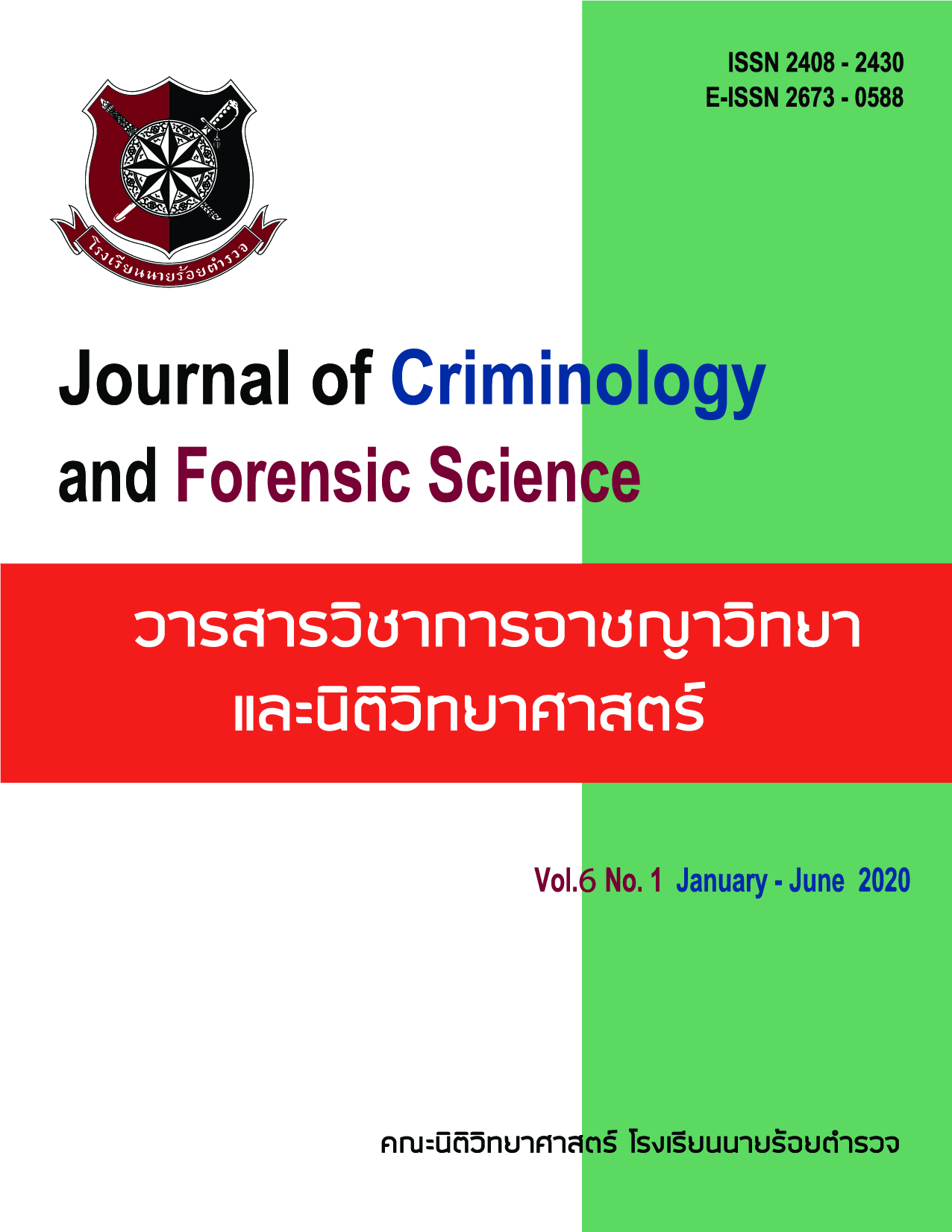การวิเคราะห์หาปริมาณธาตุสังกะสี และธาตุฟอสฟอรัส จากสารเคมีกําจัดหนู Zinc Phosphide ในตัวอย่างอาหารจากกระเพาะอาหารของศพ ด้วยเทคนิค Inductively Coupled Plasma Optical Emission Spectrometer
Main Article Content
บทคัดย่อ
การวิเคราะห์หาปริมาณธาตุสังกะสี (Zn) และธาตุฟอสฟอรัส (P) จากสารเคมีกำจัดหนู Zinc Phosphide (Zn3P2) ในตัวอย่างอาหารจากกระเพาะอาหารของศพ เป็นเป้าหมายสำคัญในการวิเคราะห์ทางด้านนิติวิทยาศาสตร์ที่ใช้สนับสนุนหาสาเหตุการตายจากการได้รับสารเคมีกำจัดหนู Zinc Phosphide งานวิจัยนี้จึงพัฒนาวิธีวิเคราะห์หาปริมาณธาตุสังกะสีและธาตุฟอสฟอรัส เพื่อพิสูจน์หาสาเหตุการตายจากการได้รับสารเคมีกำจัดหนู Zinc Phosphide ให้มีความแม่นยำมากยิ่งขึ้น และการหาอัตราส่วนระหว่างปริมาณธาตุสังกะสีกับธาตุฟอสฟอรัสจากสารเคมีกำจัดหนู Zinc Phosphide ในตัวอย่างอาหารจำลองจากกระเพาะอาหาร ตัวอย่างอาหารทั่วไปที่มีปริมาณของธาตุสังกะสีและธาตุฟอสฟอรัสสูงและตัวอย่างอาหารจากกระเพาะอาหารของศพจำนวน 75 ตัวอย่าง ด้วยเทคนิค Inductively Coupled Plasma Optical Emission Spectrometer (ICP-OES)
จากการศึกษาพบว่า ช่วงการวิเคราะห์สารละลายมาตรฐานธาตุสังกะสีและธาตุฟอสฟอรัสที่ระดับความเข้มข้น 0.5-30 µg/ml และ 12.5-500 µg/ml ตามลำดับ มีความสัมพันธ์เชิงเส้น โดยมีค่า R2 เท่ากับ 0.9995 และ 0.9998 ตามลำดับ ค่าขีดจำกัดของการตรวจวัดเท่ากับ 0.05 µg/ml และ 2.5 µg/ml ตามลำดับ ค่าขีดจำกัดของการวิเคราะห์ปริมาณเท่ากับ 0.5 µg/ml และ 15 µg/ml ตามลำดับ ความแม่นยำของวิธีวิเคราะห์แสดงด้วยค่า %Recovery เท่ากับ 96.91 % และ 98.21 % ตามลำดับ ซึ่งอยู่ในเกณฑ์การยอมรับ 80-110 % ประเมินความเที่ยงแสดงด้วยค่า %RSD เท่ากับ 0.88 % และ 1.96 % ตามลำดับ ซึ่งอยู่ในเกณฑ์การยอมรับน้อยกว่าหรือเท่ากับ 11 % และผลการศึกษาอัตราส่วนระหว่างปริมาณธาตุสังกะสีกับธาตุฟอสฟอรัสจากสารเคมีกำจัดหนู Zinc Phosphide ในตัวอย่างอาหารจำลองจากกระเพาะอาหารมีค่าเท่ากับ 3:1 ซึ่งแตกต่างจากในตัวอย่างอาหารทั่วไปที่มีธาตุสังกะสีและธาตุฟอสฟอรัสสูง นอกจากนี้ในตัวอย่างอาหารจากกระเพาะอาหารของศพมีอัตราส่วนไม่คงที่ เนื่องจากปัจจัยชนิดของอาหารที่อยู่ในตัวอย่างมีผลต่อการวิเคราะห์อัตราส่วนระหว่างปริมาณธาตุสังกะสีกับธาตุฟอสฟอรัสจากสารเคมีกำจัดหนู Zinc Phosphide
Article Details
เนื้อหาและข้อมูลในบทความที่ลงตีพิมพ์ใน วารสารวิชาการอาชญาวิทยาและนิติวิทยาศาสตร์ โรงเรียนนายร้อยตำรวจ ถิอว่าเป็นข้อคิดเห็นและความรั้บผิดชอบของผู้เขียนบทความโดยตรงซึ่งกองบรรณาธิการวารสาร ไม่จำเป็นต้องเห็นด้วยหรือรับผิดชอบใดๆ
บทความ ข้อมูล เนื้อหา รูปภาพ ฯลฯ ที่ได้รับการตีพิมพ์ใน วารสารวิชาการอาชญาวิทยาและนิติวิทยาศาสตร์ ถือว่าเป็นลิขสิทธิ์ของวารสาร วารสารวิชาการอาชญาวิทยาและนิติวิทยาศาสตร์ หากบุคคลหรือหน่วยงานใดต้องการนำทั้งหมดหรือส่วนหนึ่งส่วนใดไปเผยแพร่ต่อหรือเพื่อกระทำการใดๆ จะต้องได้รับอนุญาตเป็นลายลักษณ์อักษรจาก วารสารวิชาการอาชญาวิทยาและนิติวิทยาศาสตร์ ก่อนเท่านั้น
เอกสารอ้างอิง
Anger, F. et al. (2000). Fatal Aluminum Phosphide Poisoning, Journal of Analytical Toxicology, 24, 9–92.
AOAC. (2012). Official Methods of Analysis. 19th Edition. Washington: Association of Official Analytical Chemists.
Amornsit, M., and Petsom, A. (1996). Principles and Techniques of Instrumental Analysis. Bangkok Chuan Pim. (In Thai)
Braithwaite R. A., (2004). Metals and Anions. Clarke’s Analysis of Drugs and Poisons. London: Pharmaceutical Press.
Bumbrah, G. S., Krishan, K., Kanchan, T., Sharma, M., and Sodhi, G. S. (2012). Phosphide Poisoning: A Review of Literature. Forensic Science International, 214(1-3), 1-6.
Chan L. T. F, Crowley R. J, Delliou D, Geyer R. (1983). Phosphine Analysis in Post Mortem Specimens Following Ingestion of Aluminium Phosphide. Journal of Analytical Toxicology, 7, 165–167.
Lauterbach, M., et al. (2005). Epidemiology of Hydrogen Phosphide Exposures in Humans Reported to the Poison Center in Maintz, Germany, 1983–2003. Clinical Toxicology, 43(6), 575–581.
Marashi, S. M. (2015). A Debate Against the Current Proposed Mechanism of Phosphine Liberation in Zinc Phosphide Poisoning. Eur Rev Med Pharmacol Sci, 19(22), 4210-4211.
Musshoff, F., Preuss, J., Lignitz, E., and Madea, B. (2008). A Gas Chromatographic Analysis of Phosphine in Biological Material in A Case of Suicide. Forensic Science International, 177, e35–e37.
Proudfoot AT. (2009). Aluminium and Zinc Phosphide Poisoning. Journal of Clinical Toxicology, 47(2), 89–100.
Sadlik, J. (2011). A Case of Intoxication with Zinc Phosphide. Problems of Forensic Sciences, 88. 345–353.
SWGTOX. (2013). Scientific Working Group for Forensic Toxicology (SWGTOX): Standard Practices for Method Validation in Forensic Toxicology. Journal of Analytical Toxicology, 37(7), 452-474.
Trakulsrichai, S., Kosanyawat, N., Atiksawedparit, P., Sriapha, C., Tongpoo, A., Udomsubpayakul, U., Rittilert, P., and Wananukul. W., (2017). Clinical Characteristics of Zinc Phosphide Poisoning in Thailand. Therapeutics and Clinical Risk Management, 14(13), 335–340.
Teeyapant, P. & Chavalittumrong, P. (2013). Guidelines Analytical Toxicology. Department of Medical Sciences, Ministry of Public Health, 1(1), 21-23.
Yogendranathan, N. (2017). A Case Report of Zinc Phosphide Poisoning: Complicated by Acute Renal Failure and Tubulo Interstitial Nephritis. BMC Pharmacology and Toxicology, 18(37).


